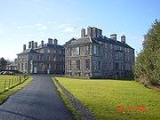
Dalkeith Palace
Encyclopedia
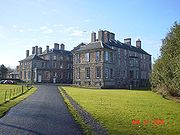
Dalkeith
Dalkeith is a town in Midlothian, Scotland, lying on the River North Esk. It was granted a burgh of barony in 1401 and a burgh of regality in 1540...
, Midlothian
Midlothian
Midlothian is one of the 32 council areas of Scotland, and a lieutenancy area. It borders the Scottish Borders, East Lothian and the City of Edinburgh council areas....
, Scotland
Scotland
Scotland is a country that is part of the United Kingdom. Occupying the northern third of the island of Great Britain, it shares a border with England to the south and is bounded by the North Sea to the east, the Atlantic Ocean to the north and west, and the North Channel and Irish Sea to the...
, is the former seat of the Duke of Buccleuch
Duke of Buccleuch
The title Duke of Buccleuch , formerly also spelt Duke of Buccleugh, was created in the Peerage of Scotland on 20 April 1663 for the Duke of Monmouth, who was the eldest illegitimate son of Charles II of Scotland, England, and Ireland and who had married Anne Scott, 4th Countess of Buccleuch.Anne...
.
Dalkeith Castle was located to the north east of Dalkeith, and was originally in the hands of the Clan Graham
Clan Graham
Clan Graham is a Scottish clan who had territories in both the Scottish Highlands and Lowlands.-Origins:Legend has it that the first Graham was one Gramus who forced a breach in the Roman Antonine wall known as Graeme's Dyke in 420 A.D...
in the 12th century and given to the Douglas family in the early 14th century. James Douglas of Dalkeith became the Earl of Morton
Earl of Morton
The title Earl of Morton was created in the Peerage of Scotland in 1458 for James Douglas of Dalkeith. Along with it, the title Lord Aberdour was granted. This latter title is the courtesy title for the eldest son and heir to the Earl of Morton....
in the mid 15th century. The castle was strategically located in an easily defensible position above a bend in the River North Esk
River North Esk
The North Esk is a river in Angus and Aberdeenshire, Scotland. It is formed by the meeting of the Water of Mark and the Water of Lee , and enters the North Sea four miles north of Montrose. It forms the boundary between Angus and Aberdeenshire at certain stages in its course...
.
Margaret Tudor
Margaret Tudor
Margaret Tudor was the elder of the two surviving daughters of Henry VII of England and Elizabeth of York, and the elder sister of Henry VIII. In 1503, she married James IV, King of Scots. James died in 1513, and their son became King James V. She married secondly Archibald Douglas, 6th Earl of...
, the bride of King James IV of Scots
James IV of Scotland
James IV was King of Scots from 11 June 1488 to his death. He is generally regarded as the most successful of the Stewart monarchs of Scotland, but his reign ended with the disastrous defeat at the Battle of Flodden Field, where he became the last monarch from not only Scotland, but also from all...
, stayed here as the guest of the Earl of Morton
John Douglas, 2nd Earl of Morton
John Douglas, 2nd Earl of Morton was the son of James Douglas, 1st Earl of Morton and Princess Joan of Scotland, Countess of Morton, daughter of James I of Scotland by his wife Lady Joan Beaufort. He became earl in 1493, upon his father's death...
before her formal entry to Edinburgh
Edinburgh
Edinburgh is the capital city of Scotland, the second largest city in Scotland, and the eighth most populous in the United Kingdom. The City of Edinburgh Council governs one of Scotland's 32 local government council areas. The council area includes urban Edinburgh and a rural area...
in 1503. In 1543, Dr. David Cardinal Beaton
David Beaton
The Most Rev. Dr. David Cardinal Beaton was Archbishop of St Andrews and the last Scottish Cardinal prior to the Reformation.-Career:...
, the Archbishop of St Andrews
Archbishop of St Andrews
The Bishop of St. Andrews was the ecclesiastical head of the Diocese of St Andrews and then, as Archbishop of St Andrews , the Archdiocese of St Andrews.The name St Andrews is not the town or church's original name...
, was imprisoned in Dalkeith Castle. The castle was captured during the war of the Rough Wooing by James Wilford
James Wilford
Sir James Wilford was an English soldier, and commander of Haddington in Scotland during its occupation in the war of the Rough Wooing....
and Thomas Wyndham
Thomas Wyndham (navigator)
Thomas Wyndham was an English naval officer and navigator.The son of Sir Thomas Wyndham of Felbrigg and Elizabeth Wentworth, he was educated at Louvain University and possibly in Italy....
on 3 June 1548. Around 1575, Regent Morton
James Douglas, 4th Earl of Morton
James Douglas, jure uxoris 4th Earl of Morton was the last of the four regents of Scotland during the minority of King James VI. He was in some ways the most successful of the four, since he did manage to win the civil war which had been dragging on with the supporters of the exiled Mary, Queen of...
, who had been captured at the siege of 1548, built a new castle there. In 1642, Dalkeith Castle was sold to the Francis Scott, 2nd Earl of Buccleuch
Francis Scott, 2nd Earl of Buccleuch
Francis Scott, 2nd Earl of Buccleuch was the son of Walter Scott, 1st Earl of Buccleuch.On 25 July 1646, he married Lady Margaret Leslie, daughter of John Leslie, 6th Earl of Rothes and they had three children:...
.

Charles II of England
Charles II was monarch of the three kingdoms of England, Scotland, and Ireland.Charles II's father, King Charles I, was executed at Whitehall on 30 January 1649, at the climax of the English Civil War...
. They became the Duke and Duchess of Monmouth & Buccleuch. After the Duke of Monmouth had been executed for treason, Anne Scott, his widow, who held the Scottish title in her own right, asked architect James Smith
James Smith (architect)
James Smith was a Scottish architect, who pioneered the Palladian style in Scotland. He was described by Colen Campbell, in his Vitruvius Britannicus , as "the most experienced architect of that kingdom".-Biography:...
to use William of Orange
William III of England
William III & II was a sovereign Prince of Orange of the House of Orange-Nassau by birth. From 1672 he governed as Stadtholder William III of Orange over Holland, Zeeland, Utrecht, Guelders, and Overijssel of the Dutch Republic. From 1689 he reigned as William III over England and Ireland...
's Palace of Het Loo
Het Loo
Het Loo Palace is a palace in Apeldoorn, Netherlands. The symmetrical Dutch Baroque building was designed by Jacob Roman and Johan van Swieten and was built between 1684 and 1686 for stadtholder-king William III and Mary II of England...
in the Netherlands
Netherlands
The Netherlands is a constituent country of the Kingdom of the Netherlands, located mainly in North-West Europe and with several islands in the Caribbean. Mainland Netherlands borders the North Sea to the north and west, Belgium to the south, and Germany to the east, and shares maritime borders...
as a model for the new Dalkeith Palace.
Smith and his cousins, Gilbert and James, signed the contract for mason work at Dalkeith Castle in March of 1702. Construction of Dalkeith Palace began later that year, Smith deciding to incorporate a portion of the tower house of the old castle into the western side of the new structure. The outline of the old tower walls is still visible in the western facade of the palace today.
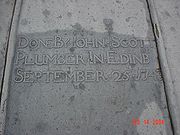
London
London is the capital city of :England and the :United Kingdom, the largest metropolitan area in the United Kingdom, and the largest urban zone in the European Union by most measures. Located on the River Thames, London has been a major settlement for two millennia, its history going back to its...
with a small party to choose items of furniture for the palace. Construction was proceeding at a steady pace, and the main portion of the palace was roofed by the end of 1705. The London marble
Marble
Marble is a metamorphic rock composed of recrystallized carbonate minerals, most commonly calcite or dolomite.Geologists use the term "marble" to refer to metamorphosed limestone; however stonemasons use the term more broadly to encompass unmetamorphosed limestone.Marble is commonly used for...
-cutter Richard Neale spent sixty-four weeks at the palace with nine assistants between 1709 and 1711, carving the main stairwell and screen of the Great Staircase. Several marble chimney pieces were installed, as well as an intricately-carved marble bas-relief of Neptune
Poseidon
Poseidon was the god of the sea, and, as "Earth-Shaker," of the earthquakes in Greek mythology. The name of the sea-god Nethuns in Etruscan was adopted in Latin for Neptune in Roman mythology: both were sea gods analogous to Poseidon...
and Galatea
Galatea (mythology)
-Name "Galatea":Though the name "Galatea" has become so firmly associated with Pygmalion's statue as to seem antique, its use in connection with Pygmalion originated with a post-classical writer. No extant ancient text mentions the statue's name...
. This internally extensive use of marble was very much the taste of the Duchess. The majority of construction was complete by 1711.
Finishing touches on the Palace complex included adding a wrought iron
Wrought iron
thumb|The [[Eiffel tower]] is constructed from [[puddle iron]], a form of wrought ironWrought iron is an iron alloy with a very low carbon...
screen with freestone piers (no longer existing) around the forecourt, a great deal of planting, and the laying out of a great avenue through the park. Dalkeith Park itself was a large area of manicured trees and gardens which in later years would include the Montagu Bridge over the North Esk River and the Dalkeith Conservatory and a grassed amphitheatre. When the final calculations were made, it was determined that the construction of Dalkeith Palace had cost the Duchess a total of Stg
Pound sterling
The pound sterling , commonly called the pound, is the official currency of the United Kingdom, its Crown Dependencies and the British Overseas Territories of South Georgia and the South Sandwich Islands, British Antarctic Territory and Tristan da Cunha. It is subdivided into 100 pence...
£17,727.
The plumber John Scott of Edinburgh
Edinburgh
Edinburgh is the capital city of Scotland, the second largest city in Scotland, and the eighth most populous in the United Kingdom. The City of Edinburgh Council governs one of Scotland's 32 local government council areas. The council area includes urban Edinburgh and a rural area...
re-plated the roof in lead in 1743. Some minor additions were carried out in the following years. John Adam
John Adam (architect)
John Adam was a Scottish architect. Born in Linktown of Abbotshall, now part of Kirkcaldy, Fife, he was the eldest son of architect and entrepreneur William Adam. His younger brothers Robert and James Adam also became architects.The Adam family moved to Edinburgh in 1728, as William Adam's career...
resurfaced the building in 1762 and James Playfair
James Playfair
James Playfair was a Scottish architect who worked largely in the Neoclassical tradition. He was born in Benvie near Dundee, where his father was the parish minister. He was the brother of William Playfair the engineer, and the mathematician John Playfair...
inserted a low window into the east facade in 1786.
Overall, the Palace is built of sandstone and has the main entrance on the south front, flanked on each side by two Corinthian order
Corinthian order
The Corinthian order is one of the three principal classical orders of ancient Greek and Roman architecture. The other two are the Doric and Ionic. When classical architecture was revived during the Renaissance, two more orders were added to the canon, the Tuscan order and the Composite order...
pilasters. These are surmounted by a bracketed pediment
Pediment
A pediment is a classical architectural element consisting of the triangular section found above the horizontal structure , typically supported by columns. The gable end of the pediment is surrounded by the cornice moulding...
unusual for its depth.
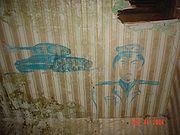
William Burn
William Burn was a Scottish architect, pioneer of the Scottish Baronial style.He was born in Edinburgh, the son of architect Robert Burn, and educated at the Royal High School. After training with the architect of the British Museum, Sir Robert Smirke, he returned to Edinburgh in 1812...
produced unexecuted designs in Jacobean
Jacobean architecture
The Jacobean style is the second phase of Renaissance architecture in England, following the Elizabethan style. It is named after King James I of England, with whose reign it is associated.-Characteristics:...
style. More minor alterations were carried out, together with improvements to the surrounding estate including a new house and offices for the Duke's Chamberlain, and the construction, for the 5th Duke, of St Mary's Church as a private chapel by William Burn and David Bryce
David Bryce
David Bryce FRSE FRIBA RSA was a Scottish architect. Born in Edinburgh, he was educated at the Royal High School and joined the office of architect William Burn in 1825, aged 22. By 1841, Bryce had risen to be Burn's partner...
. The church contains one of only two water-powered organs in Scotland.
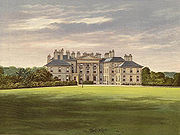
Charles Edward Stuart
Prince Charles Edward Louis John Casimir Sylvester Severino Maria Stuart commonly known as Bonnie Prince Charlie or The Young Pretender was the second Jacobite pretender to the thrones of Great Britain , and Ireland...
stayed two nights at Dalkeith in 1745, King George IV
George IV of the United Kingdom
George IV was the King of the United Kingdom of Great Britain and Ireland and also of Hanover from the death of his father, George III, on 29 January 1820 until his own death ten years later...
slept here during his visit to Edinburgh in 1822, in preference to Holyroodhouse Palace which was in a poor state, as did Queen Victoria
Victoria of the United Kingdom
Victoria was the monarch of the United Kingdom of Great Britain and Ireland from 20 June 1837 until her death. From 1 May 1876, she used the additional title of Empress of India....
in 1842.
During World War II
World War II
World War II, or the Second World War , was a global conflict lasting from 1939 to 1945, involving most of the world's nations—including all of the great powers—eventually forming two opposing military alliances: the Allies and the Axis...
, Polish troops of the 3rd Flanders Rifle Brigade, part of the 1st Polish Armoured Division, were quartered on the third floor of Dalkeith Palace from 1942 onwards. Graffiti
Graffiti
Graffiti is the name for images or lettering scratched, scrawled, painted or marked in any manner on property....
drawn by these troops is still visible on the third floor wallpaper of the Palace as of 2008.

International Computers Ltd.
International Computers Limited, or ICL, was a large British computer hardware, computer software and computer services company that operated from 1968 until 2002 when it was acquired, and renamed Fujitsu Services Limited after its parent company, Fujitsu...
(ICL), who leased the Palace until 1983.
Dalkeith Palace has not been lived in by the Buccleuch family since 1914 and has been leased to the University of Wisconsin system for a study abroad
Study abroad
Studying abroad is the act of a student pursuing educational opportunities in a country other than one's own. This can include primary, secondary and post-secondary students...
programme since 1985. Approximately 60-80 students a semester live in the palace, where they also take classes from U.S. and UK faculty members.

